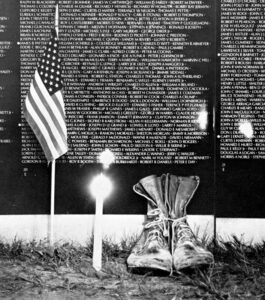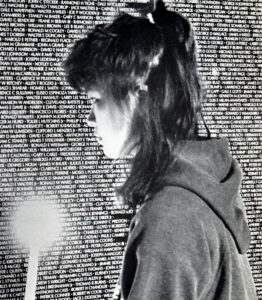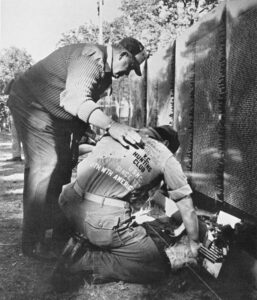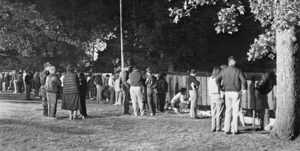
April 30, 1975 is known as the day Saigon fell. Last week, the 40th anniversary was acknowledged across our nation with televised documentaries and a mention on national newscasts. In America, the Vietnam war still conjures up different emotions, largely depending on one’s age. But for the American soldier who spent “time in country,” there is hardly a descriptive word to adequately encompass the depth and breadth of their experiences. Sometimes, no words say a lot.
 The empty boots signify the cost of war. CBC funded and arranged to have ‘The Moving Wall,’ a replica of the Vietnam Veterans Memorial, visit Raleigh and Fayetteville in 1987.
The empty boots signify the cost of war. CBC funded and arranged to have ‘The Moving Wall,’ a replica of the Vietnam Veterans Memorial, visit Raleigh and Fayetteville in 1987.
First, a little history regarding the Vietnam War Memorial, or “The Wall.” In 1980, President Jimmy Carter designated the Constitution Gardens on the National Mall as a location for a memorial. The Vietnam Veterans Memorial Fund formed a committee to consider various options as to how to honor those who served in the military during the conflict. The memorial committee opened up the competition for public entries. The Vietnam Veterans Memorial Fund’s criteria were that the memorial be “contemplative and reflective in character” and “not a political statement.” Also, the memorial had to be cohesive with the surroundings and bear the names of those who died in the conflict or who were still missing.
There were a total of 1,421 entries. The memorial committee chose the winner, Maya Lin, a senior at Yale University. Her design was minimalist and nontraditional. The memorial is a polished black, V-shaped granite slab seemingly rising from the ground. The strength of the granite contrasts with softness of the grass and brings a balance to both nature and architecture. Upon it bears the names of over 58,000 Americans who were killed or are missing.
 CBC funded and arranged to have ‘The Moving Wall,’ a replica of the Vietnam Veterans Memorial, visit Raleigh and Fayetteville in 1987.
CBC funded and arranged to have ‘The Moving Wall,’ a replica of the Vietnam Veterans Memorial, visit Raleigh and Fayetteville in 1987.
Initially, Lin’s design was as divisive as the war. War memorials conjure up images like the iconic Iwo Jima statue of Marines raising the US Flag, or a stately obelisk that directs our eyes to the sky. Lin’s design was different. The polished black granite with the names of those who did not return home beckons one to come close, very close to the monument. Soon the names, upon names, upon names start to overwhelm you. When you reach out to touch an etched name on the monument, your reflection appears to be someone on the other side reaching back to touch you. That is a moment beyond description.
 A man comforts an emotional vet at the replica of the Vietnam Veterans Memorial CBC funded and arranged to have visit Raleigh and Fayetteville in 1987.
A man comforts an emotional vet at the replica of the Vietnam Veterans Memorial CBC funded and arranged to have visit Raleigh and Fayetteville in 1987.
In 1987, Capitol Broadcasting funded and arranged one of the most extraordinary public service projects to come to Raleigh and Fayetteville; The Moving Wall. The monument is a half-scaled replica of the Vietnam Veterans Memorial in Washington, D.C. Capitol Broadcasting President, Jim Goodmon, who initiated the project was quoted in a CapCom article from 1987, “We think this was a fitting tribute to our veterans. Many Vietnam vets got a raw deal during and immediately after the war. We wanted to do this for all of them, and for their families and friends in North Carolina.” The Moving Wall is more than simply mobile, it is very moving, in the emotional sense.
The event’s theme was, “To Reflect, Remember, and Pay Tribute.” The theme was meaningful for more than 38,500 persons who visited The Moving Wall in Raleigh and Fayetteville from October 7-13, 1987. The Memorial was on display day and night at Meredith College in Raleigh and Fayetteville Technical Institute in Fayetteville.
 CBC employees (L-R, Tim Grissom on his knees with sledge hammer and other CBC Management employees) place flags around ‘The Moving Wall,’ a replica of the Vietnam Veterans Memorial CBC funded and arranged to have visit Raleigh and Fayetteville in 1987.
CBC employees (L-R, Tim Grissom on his knees with sledge hammer and other CBC Management employees) place flags around ‘The Moving Wall,’ a replica of the Vietnam Veterans Memorial CBC funded and arranged to have visit Raleigh and Fayetteville in 1987.
CBC employees participated on just about every level. CBC VP of administration, Ben Waters, handled planning and supervision of the project. WRAL-TV, WRAL-FM and North Carolina News Network (NCNN) provided promos and public service announcements, while WRAL-FM news and NCNN produced a 42-part series on “Vietnam Veterans: Are They Winning the War?” Bob Inskeep and “Tack” from WRAL-FM, and Bill Leslie and John Hudson from WRAL-TV news hosted various ceremonies during The Moving Wall display. Even CBC Property Management got involved placing flags in appropriate places near the displays.
 A candlelight vigil at ‘The Moving Wall,’ a replica of the Vietnam Veterans Memorial CBC funded and arranged to have visit Raleigh and Fayetteville in 1987.
A candlelight vigil at ‘The Moving Wall,’ a replica of the Vietnam Veterans Memorial CBC funded and arranged to have visit Raleigh and Fayetteville in 1987.
Candlelight services were held in Raleigh and Fayetteville honoring the veterans. The National Guard Army Band and the Raleigh Boychoir provided an evening performance at the Meredith Amphitheatre. One of the highlights of the Raleigh and Fayetteville ceremonies was the appearance of the Joint Services Honor Guard from Washington, D.C.
WRAL’s Bill Leslie gave a tribute during the candlelight services in Raleigh that summed up what The Moving Wall was all about: “With these memorials, America is finally saying ‘Welcome Home,’ to our vets. America is finally applying that medicine called ‘honor’ to the wounds of the Vietnam veterans. And I think we’re beginning to see a difference. You can see it in their eyes. You can hear it in their hugs and handshakes. Our veterans are on the mend. Their wounds are healing. A truce has been declared in that war within.”
CBC has many current and past employees who are Vietnam and Vietnam era veterans. Thank you for your service.
Thanks to Corp’s Pam Allen for this capcom story. Pam Parris Allen is a former WRAL newscast producer/director who now works as a researcher and producer on the CBC History Project.
CBC funded and arranged to have ‘The Moving Wall,’ a replica of the Vietnam Veterans Memorial, visit Raleigh and Fayetteville in 1987.
CBC employees (L-R, Tim Grissom on his knees with sledge hammer and other CBC Management employees) place flags around ‘The Moving Wall,’ a replica of the Vietnam Veterans Memorial CBC funded and arranged to have visit Raleigh and Fayetteville in 1987.
A man comforts an emotional vet at the replica of the Vietnam Veterans Memorial CBC funded and arranged to have visit Raleigh and Fayetteville in 1987.
The empty boots signify the cost of war. CBC funded and arranged to have ‘The Moving Wall,’ a replica of the Vietnam Veterans Memorial, visit Raleigh and Fayetteville in 1987.
A candlelight vigil at ‘The Moving Wall,’ a replica of the Vietnam Veterans Memorial CBC funded and arranged to have visit Raleigh and Fayetteville in 1987.